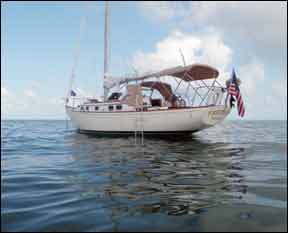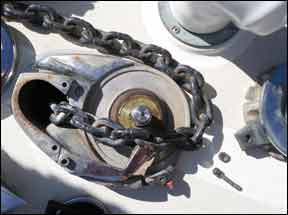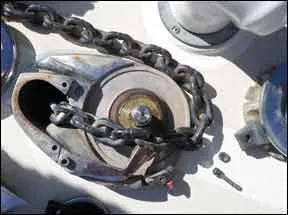Taking the advice of a PS review, I installed a Lewmar V2 windlass on my boat in 2008. I went with the installers recommendation of 100 feet of galvanized chain and 100 feet of eight-part braid, connected with a rope-to-chain splice, and I have a Delta 35 anchor.
I found that a chain hockle (a twist in the chain that jams the windlass) will terribly mangle the vertical windlass. I have just completed my second mangling and ordered replacement parts-but these parts will not save me from the next mangling. The Lewmar distributor told me to install a chain swivel, but PS has warned about this (PS Advisor, May 2010). Is an all-chain rode a dumb idea? Is there some solution?
Scott Rimmer
Freedom, 1982 Sea Sprite 34
Tampa Bay, Fla.
In our experience, compact vertical windlasses are a compromise and do not strip chain as well as horizontal windlasses. However, an all-chain rode is never a bad idea. Using three-strand rope rode on a windlass is actually more likely to cause hockles, because of the way the line is twisted during manufacturing.

Ralph Naranjo
Chain hockles can be the result of a too-shallow anchor locker or the chain having low-quality, rough galvanizing or weld splatter, which prevents the links from untangling themselves. Lewmar recommends windlass owners use stainless chain because of its smoother finish. However, we do not recommend ever using stainless anchor chain; instead, stick with good-quality galvanized, and try these troubleshooting tips. First, ensure that your anchor locker has good depth under the windlass. The rode stows by gravity, and when the hawse pipe opening is at a lower level than the center of the windlasss chain wildcat, the chain twists as it goes into the locker and causes a problem when it comes out. Having a strong hawse-pipe helps too: It can take the brunt of hockle jams.
We also recommend pulling all of your anchor rode out of your chain locker at least once a season, laying it out straight or in very long bights on the deck or the dock, and then feeding it back into the anchor locker in good order. This should help prevent chain hockling in most circumstances.

Scott Rimmer
You can also try using your diesel to take the load off the anchor rode as you retrieve the scope. When you get to a 1:1 scope, power forward to free the anchor. As the freed anchor hangs from the stem roller, the chain will spin, clearing hockles from the tackle.
Now, should you install a swivel? This has been a topic of longstanding debate, and we are decidedly with the anti-swivel camp. Lewmar, however, recommends using anchor swivels.
Swivels are notorious weak points (PS Advisor, May 2010, and Mailport, January 2011). Our disdain for them-especially stainless ones- stems from frequent inconsistencies in the materials and manufacturing processes and the fact that stainless can fail without warning. But if you often anchor where your boat is turned around by current, traffic, and/or wind changes, then a galvanized swivel might help the chain untwist when hauling it in. But before making the leap to an anchor swivel, try the tips we mentioned.




































